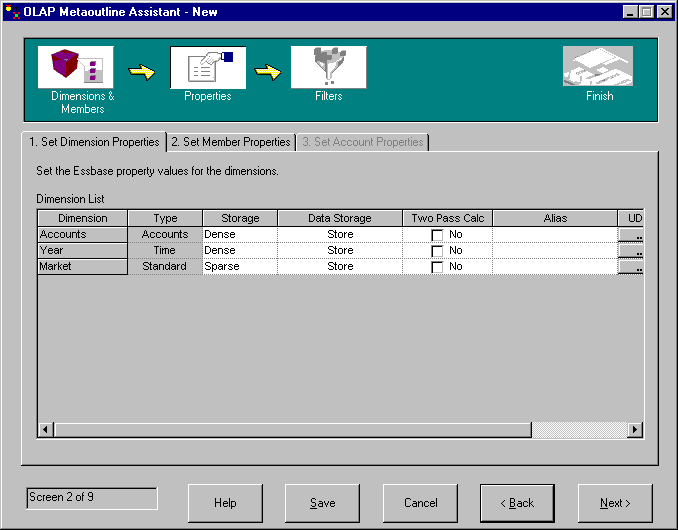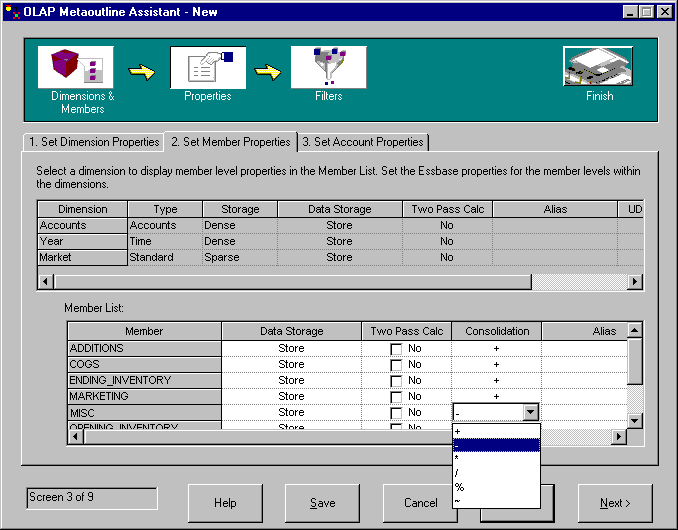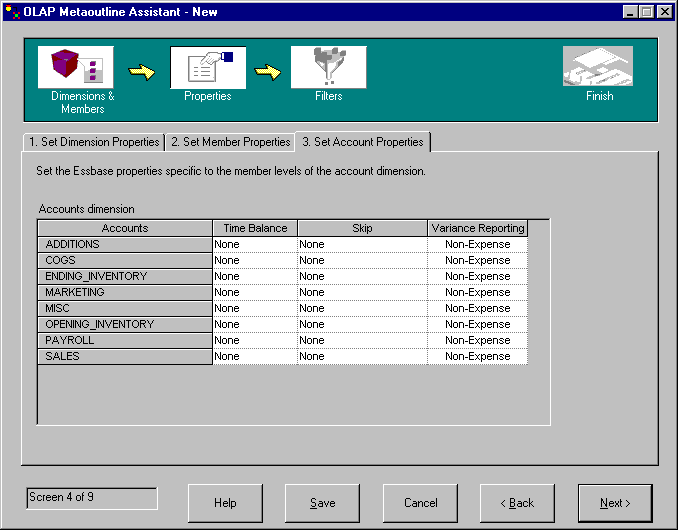Business Intelligence Tutorial
In this lesson, you will explore the properties of
dimensions and members, and change one of the properties of a member of the
Accounts dimension. These properties control how the Essbase outline is
built in the OLAP application. You will also examine special properties
of the Accounts dimension.
- On the Set Dimensions Properties page, notice how the properties of the
dimension are displayed to the right of the dimension name.

The fields in white are properties of the dimension that you can
change. These properties affect all the members of a dimension.
- Storage
- Dimensions can be either Dense or Sparse. A Dense dimension is
likely to contain data for every combination of dimension members, for
example, the Time dimension. A Sparse dimension has a low probability
that data exists for every combination of dimension members, for example, the
Product or Market dimensions.
- Data Storage
- This property determines how and when data values are stored for a
member. For example, you can store the value (the default), dynamically
calculate and store the value, indicate that a member is shared between
dimensions, and so on.
- Two Pass Calc
- Calculations are performed from the bottom up, from child values to parent
values. The values of some child members might depend on parent values,
requiring two calculations.
- Alias
- You can assign an alias name to the dimension.
- UDAs
- You can create a user-defined attribute (UDA) for the dimension.
- Click Next and the Set Member Properties page is
displayed.
In this exercise you will change a property for a dimension
member.
- Notice how the properties of the member are displayed to the right of the
member name. The fields in white are properties of the dimension that
you can change:
- Data Storage
- This property determines how and when data values are stored for a
member. For example, you can store the value (the default), dynamically
calculate and store the value, indicate that a member is shared between
dimensions, and so on.
- Two Pass Calc
- Calculations are performed from the bottom up, from child values to parent
values. The values of some child members might depend on parent values,
requiring two calculations.
- Consolidation
- This property determines how child values are rolled up to parents.
The default is a plus sign (+), which means the child values are added to
the parent value.
- Alias
- You can assign an alias name to the dimension.
- UDA
- You can create a user-defined attribute (UDA) for the dimension.
- On the Set Member Properties page, you can change some of the properties
for individual members that you previously set for the entire dimension, plus
one that is unique to members. Under the Dimension heading,
click the Accounts dimension. Notice that the members are displayed in
the Member List field.
- Under the Data Storage heading, click the value in the
Consolidation column for the MISC member. A list
box button opens in the cell. Change the property to a minus sign
(-).

Now, when the values in the Misc member are rolled up into the Accounts
dimension, the Misc values will be subtracted, not added.
- Click Next and the Set Accounts Properties page is
displayed.
In this exercise you will examine special properties for members of the
accounts dimension:
- On the Set Account Properties page, you can change the following
properties for members of the Accounts dimension:
- Time Balance
- This property defines how a member's parent is calculated in the Time
dimension. The parent can represent the value of the first
member. The default value of None allows an existing calculation
associated with the member to determine the parent. Other values
include First (the first value in a time period), Last (the last value in a
time period), or Average (an average of all the values in the time
period).
- Skip
- This property determines whether to skip a member when calculating a
parent.
- Variance Reporting
- In Variance Reporting, the difference between budget and actual data is
calculated.

- For the Accounts dimension, you can set these properties for each
member:
- Click Next and the Name Filters page is displayed.
In this lesson, you explored the properties of dimensions and members,
and changed one of the properties of a member of the Accounts
dimension. You also examined special properties of the Accounts
dimension.
[ Top of Page | Previous Page | Next Page ]


